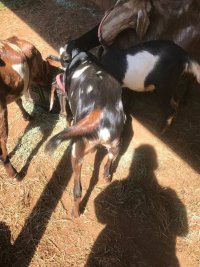- Thread starter
- #11
Deecarter
Loving the herd life
My goats love it, but I agree it is expensive and there's a lot of waste, but I am having trouble finding good quality alfalfa hay. I'd like the 2nd cutting as I've read it is more nutritious? I would like to buy a round bale and just store it in the barn. I fear it is meningeal worm. I am going to follow the directions for that and see if I can get an improvement, but the article says the nerve damage is not reversible. That's awful! After she kidded last fall is when this started and the vet gave me a lot of medication to treat her and the rest of the goats including wormers and antibiotics. I wormed again about 6 weeks later, so I feel I have done nothing but worm them since I bought them. I bought a microscope but I haven't had time to try it out yet. It all seems very overwhelming, especially when I already have a sick goat. It's very discouraging. I feel I am just spending hundreds of dollars and can't get a healthy herd going. I should have been more cautious with my purchase. Just too trusting. And I really think it could be the deer population on our property along with the creek. I have a garden and I can attest to the fact we have loads of slugs and snails.I find the tsc hay too course and blasted for my goats to want to eat it-also very expensive-but that is a source of calcium if free fed and they actually eat it. Whatever works for you!
You may want to move onto ruling out meningeal worm, polio, or listeriosis for the weird very concerning symptoms she's displaying, but calcium and a good protein source is a good first step for conditioning. The next step is running a fecal-maybe looking up meadow mist lab might help you if your vet is too pricy. For me only liver flukes can squeak by in one, but I do my own.
Good grain, good hay, additional alfalfa, and a low worm count are the best you can do for conditioning a goat.
Something I missed, but you may want to rule out cae and johnnes (and cl while you're at it, as it doesn't add much price wise). Wasting and some neurological symptoms can be displayed by affected individuals. If you are dealing with either of those two you are fighting losing battle unfortunately and it's better to know.

